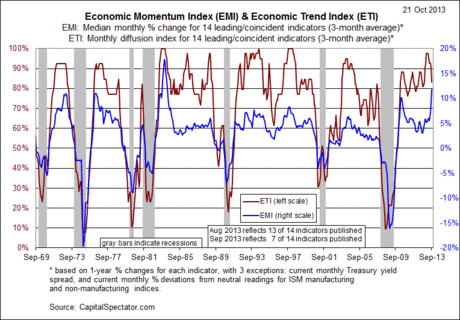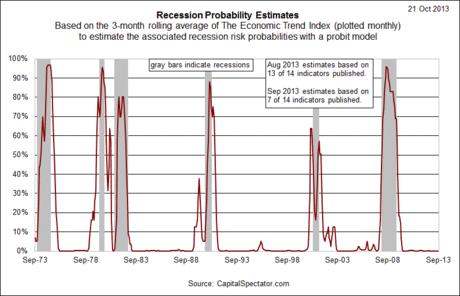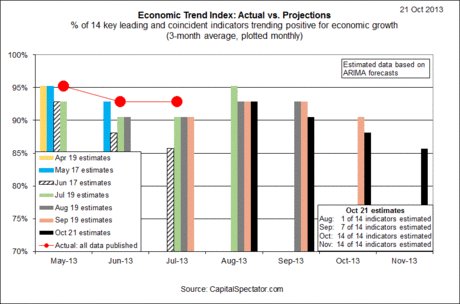The missing economic reports due to the government shutdown will start arriving this week and beyond, beginning with tomorrow’s employment report for September. Meanwhile, let’s consider what the available numbers tell us about the state of the US business cycle. Based on the latest data, economic risk remains low through last month. This profile comes with an unusual caveat, of course: several key indicators are still MIA. At this point in the month we should have already seen September numbers on payrolls, retail sales, industrial production, and new housing starts. Those updates are coming, but for now we’re clueless. Nonetheless, let’s kick the macro tires for an update look at the trend, albeit one that’s impaired by limited data.
For the moment, consumer sentiment and oil are the only sources of red ink in the September column for the indicators that comprise the Economic Trend (ETI) and Momentum indexes (EMI). Otherwise, the broad trend was positive last month, as it has been for some time. That’s a clue for assuming that the NBER will not declare September as the start of a new recession.
Here’s a closer look at how the various indicators for ETI and EMI compare in recent months:

Reviewing ETI and EMI in historical context shows that both benchmarks remain well above their respective danger zones: 50% for ETI and 0% for EMI. If the indexes fall below their respective tipping points, that would be a sign that recession risk is elevated.

Translating ETI’s historical values into recession-risk probabilities via a probit model also suggests that business cycle risk is low.

For some perspective on how ETI’s values may evolve as new data is published, let’s review projected values for this index with an econometric technique known as an autoregressive integrated moving average (ARIMA) model, based on calculations via the “forecast” package for R, a statistical software environment. The ARIMA model estimates the missing data points for each indicator, for each month through November 2013. (July 2013 is currently the latest month with a complete set of published data). Based on this projection, ETI is expected to remain well above its danger zone in the near term. Forecasts are always suspect, of course, but recent projections of ETI for the near term have proven to be relatively reliable guesstimates vs. the full set of monthly reported numbers that followed. As such, the latest projections (the four black bars on the right in the chart below) offer some support for cautious optimism. For comparison, the chart below also includes ARIMA projections published on these pages in previous months, which you can compare with the complete monthly sets of actual data that followed, based on current data (red circles). The assumption here is that while any one forecast is likely to be wrong, the errors may cancel one another out to some degree by aggregating a broad set of forecasts.

For additional context for judging the value of the forecasts, here are previously published ETI and EMI updates for the last three months:
19 Sep 2013
19 Aug 2013
19 July 2013